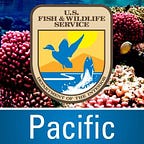The Struggle is Real: A Closer Look at the Interdependence Between ʻŌhāwai and ʻIʻiwi
By Nanea Valeros, Public Affairs Specialist, U.S. Fish and Wildlife Service
Biologically speaking, many living things interact with other living things. In fact, they may depend on these other living things to survive. This is known as interdependence and results in unique relationships in nature. Here in Hawaiʻi, endemic nectarivorous birds developed interdependent relationships with endemic plants. Plants like ʻōhiʻa (Metrosideros polymorpha), hāhā (Cyanea sp.), and ʻōhāwai (Clermontia sp.) depend on birds like ʻapapane (Himatione sanguinea) and ʻiʻiwi (Drepanis coccinea) for pollination; likewise, these birds depend on the same plants for food. These relationships are vital to healthy ecosystems, but also impact the relationships people have with ʻāina (land; that which feeds us physically, mentally, and spiritually). In Hawaiʻi, Native Hawaiians have a number of customs and traditions born from the interdependent relationships between people and ʻāina. One such cultural practice I’ve been privileged to learn is feather work.
Traditionally, feathers were used to make adornments such as helmets, capes, kāhili (feather standards), and lei for royalty and other important people. There were different methods for catching forest birds to harvest their feathers — one method utilized the interdependent relationship between nectar-sipping birds and the ʻōhāwai flower.
Kuʻu aloha i ka pua ʻōhāwai, ʻo ia pua luhe wale mai i ka nahele.
Translation: My precious love for the ʻōhāwai blossom, the flower that droops in the forest.
Meaning: The blossom of the ʻōhāwai droops and is a favorite for nectar birds.
Kia manu (bird catchers) spent a lot of time observing forest birds and learned that certain birds favored certain flowers. For example, nectar-sipping birds like the ʻiʻiwi favored tubular or bell-shaped flowers like the ʻōhāwai. So to catch these birds, kia manu would hide in a shrub and stick out their hand, holding an ʻōhāwai flower, and wait for an ʻiʻiwi to come and sip the nectar. Once the ʻiʻiwi perched, inserted its beak into the flower, and started sipping, the kia manu would gently pinch the beak with his fingers, pluck a few feathers, then set the bird free. They would do this over and over until they had enough feathers, maintaining a sustainable system of collection. Traditionally, feather adornments were reserved for royalty and important people because the process of making these adornments was no easy feat. This cultural practice was dependent upon a healthy forest, the persistence of forest bird species, and the relationships built between people and ʻāina.
The traditional practices of bird catching and feather work in Hawaiʻi have been lost ultimately because of the loss of our forest bird species. Historically, there were over 50 different nectar birds in Hawaiʻi. In 2021, only 17 species remain, many on the brink of extinction like the ʻiʻiwi. The loss and continued decline of our forest bird species are the result of habitat loss, invasive species, and disease.
Today, some Native Hawaiians still practice the art of feather work; however, the process has been modified. Instead of catching native birds in the forest, feathers of non-native bird species are bought at the store. Also, since Hawaiʻi is no longer ruled by chiefs or monarchs, adornments such as helmets, capes, and kāhili are rarely made. Lei hulu (feather lei) are the most common of all feather work seen today, and are not necessarily seen as a status symbol, but more so as a representation of love. Lei hulu are also observed in hula and can be indicative of hula lineage.
ʻŌhāwai and ʻiʻiwi are just two examples of interdependent endemic species, struggling to survive as they face habitat loss, increased pressure from non-native plants and predators, and a changing climate. Both species are listed under the Endangered Species Act and the U.S. Fish and Wildlife Service (the Service), conservation agencies, and other organizations are working to prevent their extinction. Forest birds like the ʻiʻiwi are at risk from a disease called avian malaria, which is transmitted by non-native mosquitoes. Once, birds like ʻiʻiwi could be found from mountain tops all the way down to the ocean. But wherever mosquitoes are, forest birds cannot survive. As the climate changes, mosquitoes are increasing their range from lower, warmer elevations and moving higher and higher into the mountains. This decreases the amount of safe space left for forest birds. The Service, State of Hawaiʻi, and our partners are working on a long-term solution to prevent the spread of mosquitoes and save Hawaiʻi’s forest birds from imminent extinction.
While the task seems daunting, there is hope for our beloved forest birds. One small way you can help to protect endemic forest birds and plants is to talk to about them with your family and friends. Share moʻolelo (stories) about kia manu and mele (songs) about birds and talk about how awesome it would be see such an increase in population numbers that traditional practices like bird catching and feather collection could once again be a part of our modern day cultural practices. How special would it be to make a lei hulu for a loved one from native forest bird feathers, collected the same way as our kūpuna (ancestors) did? Keep the conversations going and continue to strengthen your relationships with ʻāina so that one day, our children’s children will be able to make these connections and build interdependent relationships with ʻāina, too.
Learn more about Birds Not Mosquitoes
The U.S. Fish and Wildlife Service works with others to conserve, protect, and enhance fish, wildlife, plants, and their habitats for the continuing benefit of the American people. For more information, connect with us through any of these social media channels at https://www.facebook.com/PacificIslandsFWS, www.flickr.com/photos/usfwspacific/, or www.twitter.com/USFWSPacific.
